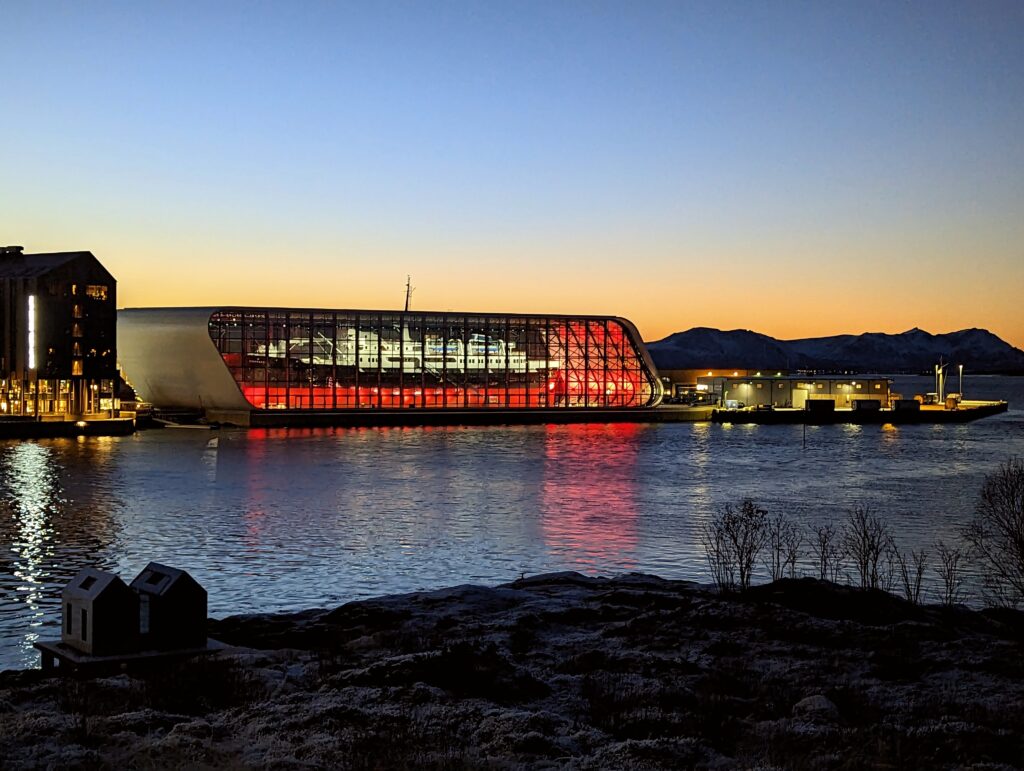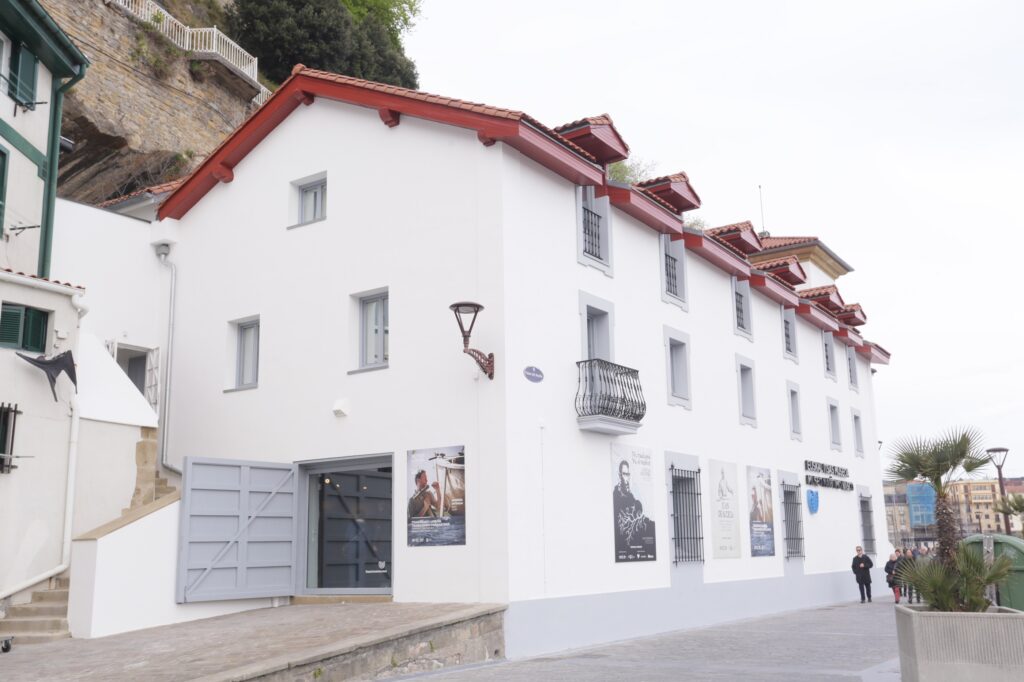Widely varying in themes and scope, maritime museums highlight aspects of sea culture in a particular place, be it a small village or a whole country. Here are 20 must-visit options along Europe’s seaboards.
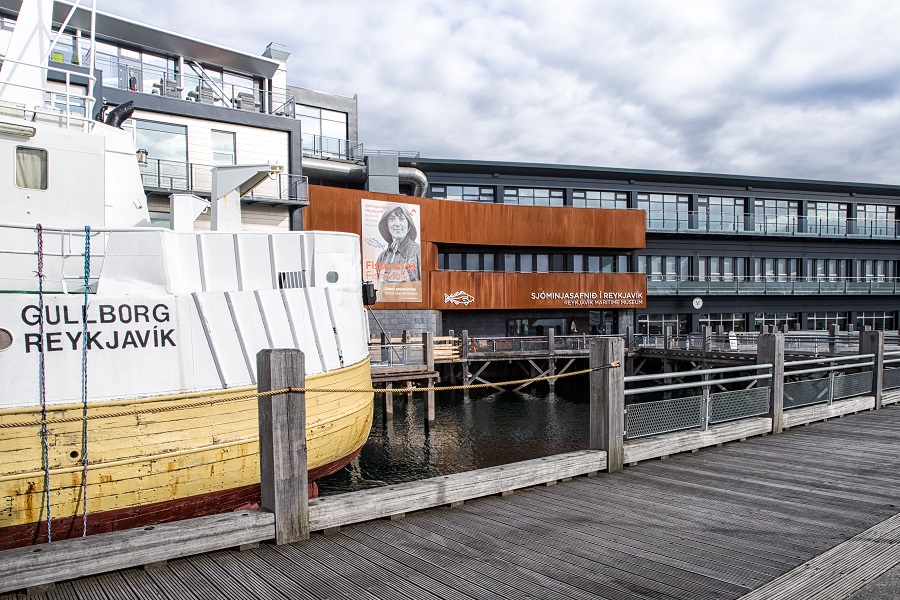
The Reykjavik Maritime Museum (Photo: Javier Ballester, courtesy of Reykiavik Maritime Museum)
Reflecting the vastness of their main subject – the sea – maritime museums form a virtually boundless category. The ‘classic’ examples have a national scope, aiming for an all-encompassing account of a country’s naval history. More specific approaches might revolve around a traditional craft, a disappeared coastal community, a living one, an ancient ship or a famous shipwreck – to name but a few possible topics. Other museums will cast their gaze on the maritime culture of a whole region, investigating the manifold relation between civilisation and the sea in its universal and particular consequences.
While some national museums feature in our list, we have prioritised those exploring more defined facets of the maritime world. Our selection also favours original approaches to the museum experience, usually involving interactive and multimedia exhibits. Seeking an equal distribution across the European map, we have set a limit of two museums per country (although not every country could be featured). Finally, we wanted to best represent the diversity of options available by including a mix of local and regional museums, whose size and scope differ considerably. With these criteria in mind, we present to you some of the best maritime museums in Europe, listed in no particular order.
Museu Marítim de Barcelona, SPAIN
Located in the historic shipyard of Barcelona, this museum offers an innovative and participative approach to investigating maritime culture. While the focus falls on the relationship between Catalonia and the sea, the museum’s scope embraces the whole Mediterranean region. The rich collection of artefacts goes back centuries and includes 85 vessels, ten of which are fully operational. Current long-term exhibitions showcase local history through the lives of seafarers from different eras, as well as the rise of Catalonia as an industrial power.
Av. de les Drassanes, 1, 08001 Barcelona, Spain

Replica stern of the ‘Real’, flagship of Don Juan of Austria at the Battle of Lepanto, 1571 (Photo: Richard Mortel via Wikimedia Commons / cc by 2.0)
Reykjavik Maritime Museum, ICELAND
This former fish-freezing plant in the old harbour explores the crucial role fishing plays in Iceland’s history and economy. The permanent exhibition is ‘Fish and Folk’ launched in 2018. It displays film, photos and interactive items merging an immersive approach with the evocative ambience of a fish-processing factory. The machine room hosts temporary exhibitions, currently a video installation exploring nature’s transformative process through a dreamy and poetic gaze (‘We Are Earth – We Are Water’). Head to the Coast Guard vessel Óðinn for an insight into the 1950s and 1970s Cod Wars between Iceland and the United Kingdom.
Grandagarður 8, 101 Reykjavík, Iceland
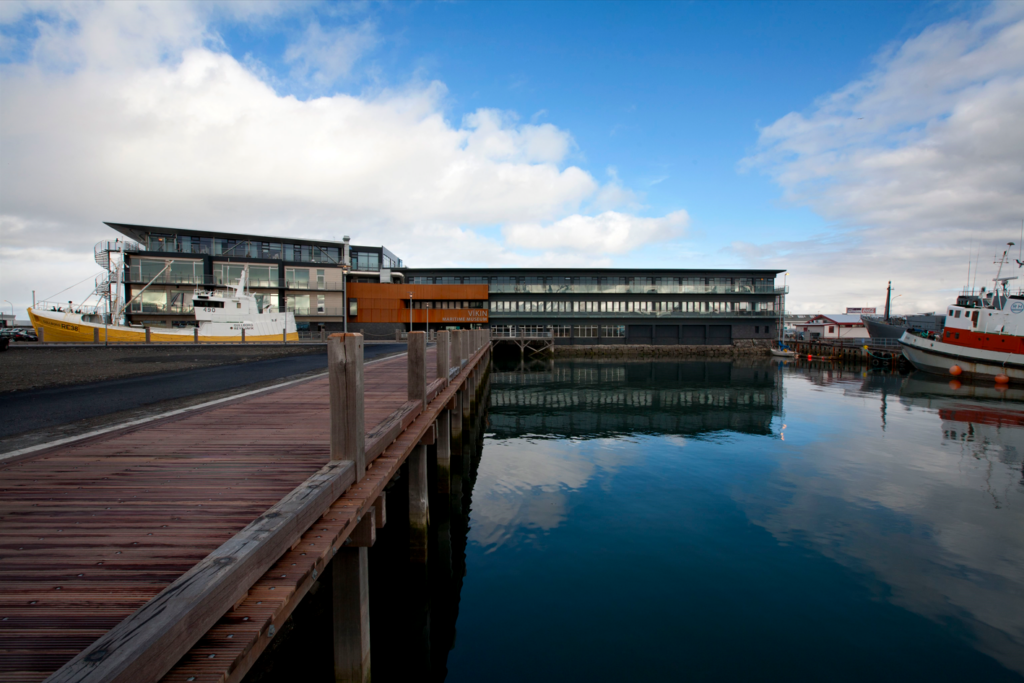
Former fish-freezing plant, turned museum (Photo: courtesy of Reykjavik Maritime Museum)
M/S Maritime Museum of Denmark, DENMARK
Award-winning architecture completed in 2013, this underground concrete gem is lodged in a former dry dock. Ramps and bridges cross the empty dock, guiding visitors around, while uneven floors and irregular angles further the impression of being aboard a ship. The permanent displays are just as original. Film, texts, artefacts and interactive installations explore intriguing topics such as myths about sailors (with sailor tattoos available for visitors!), the lives of their families, early globalisation and modern shipping. The current temporary exhibition focuses on women divers on the island of Jeju, South Korea. The M/S Maritime Museum is part of the recently-renovated cultural centre (Kronborg Culture Harbour). A special guided tour is held every Saturday as part of the programme of Copenhagen World Capital of Architecture 2023.
Ny Kronborgvej 1, 3000 Helsingør, Denmark
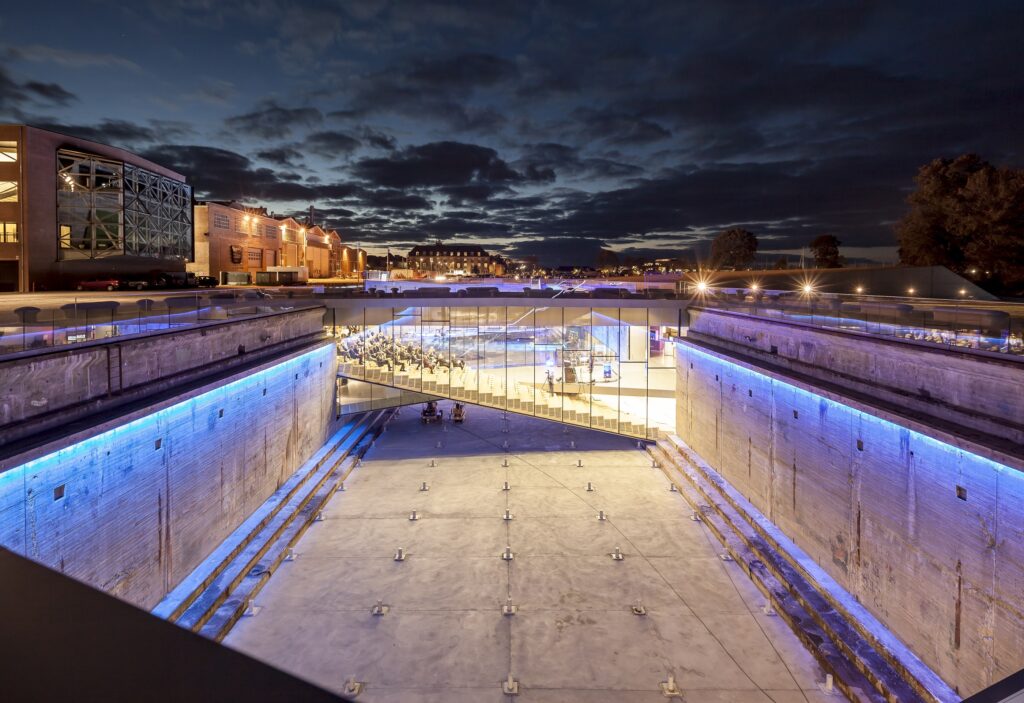
The Maritime Museum of Denmark at night (Photo: Luca Santiago Mora, courtesy of M/S Museet for Søfart)
Galata Maritime Museum, ITALY
Perhaps the most ambitious museum of its kind in the Mediterranean region, the Galata is located in the former shipbuilding hub of Genoa’s old harbour. The showpiece is a faithful replica of a 17th-century galley, enriched by playful interactive stations showing life on board. Other rooms explore Mediterranean history through the rise and fall of the Republic of Genoa, from the Late Middle Ages to Napoleonic times. Insights on shipwrecks, fishing, maps and maritime art are also featured, and a ship simulator is available. A whole floor houses an immersive exhibition on Italian migration, an excellent introduction to the brand-new National Museum of Italian Emigration located across the street (joint tickets available). Access to the Nazario Sauro submarine is included in the visit.
Calata Ansaldo De Mari, 1, 16126 Genoa, Italy
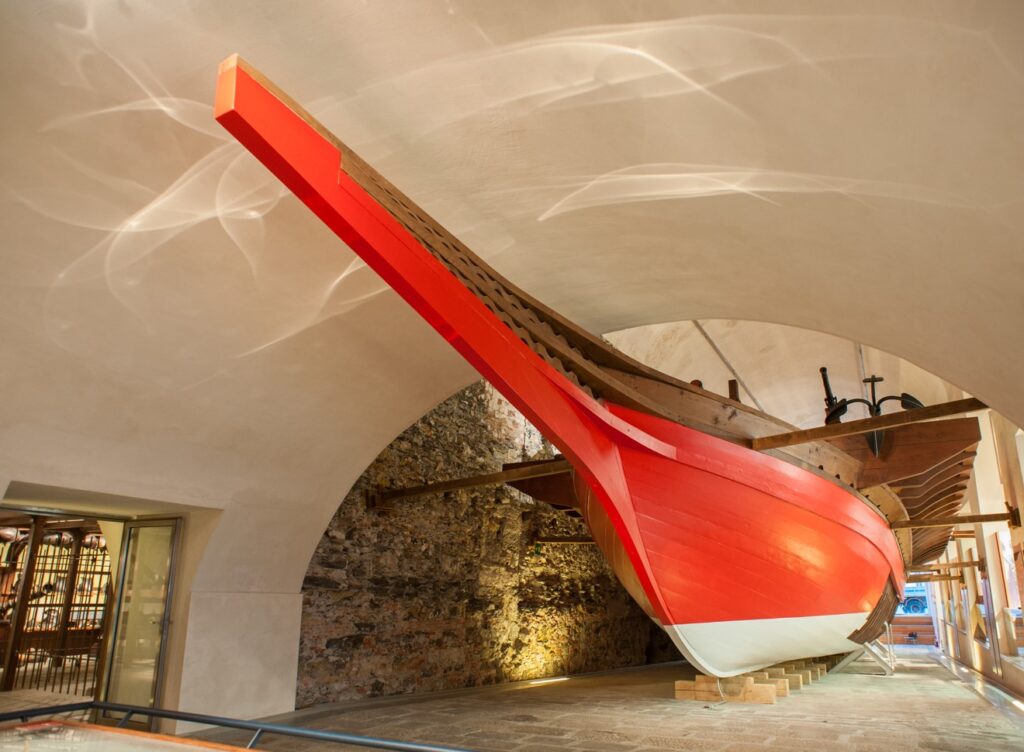
The life-size replica of a 17th-century galley (Photo: courtesy of Galata Museo del Mare)
Zuiderzeemuseum, NETHERLANDS
This Dutch museum aims to keep the cultural heritage of the Zuiderzee alive. The inland maritime region was transformed by the construction of the Afsluitdijk dam in 1932. The museum is split between an indoor and an outdoor part, the latter area consisting of an actual village formed of 140 historic buildings, allowing visitors to experience local life as it used to be lived. Highlights include a post office, fish-smoking houses and workshops providing hands-on experience with ancient crafts. The indoor space includes the Ships Hall, along with other temporary and permanent exhibitions. An array of historic artefacts from the region is displayed, with audio stories bringing this former community back to life.
Wierdijk 12 – 22, 1601 LA Enkhuizen, Netherlands
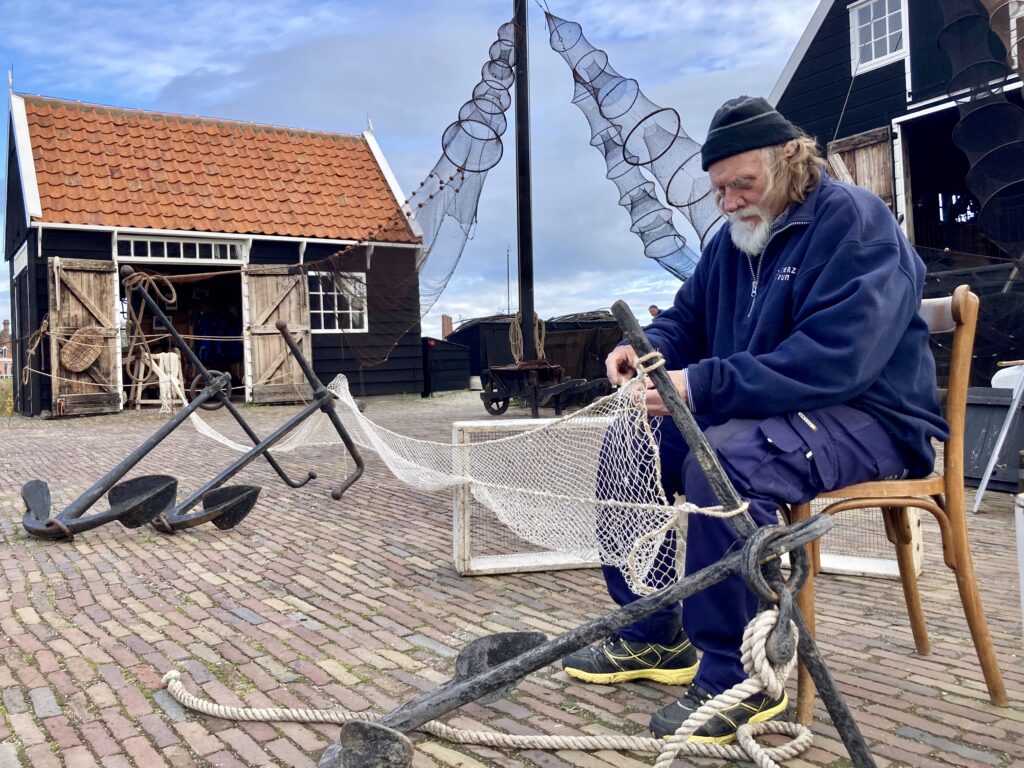
A net mender at work (Photo: Corinne de Kroon, courtesy of Zuiderzeemuseum)
Museum of London Docklands, UNITED KINGDOM
Housed in a Georgian sugar warehouse, the Museum of London Docklands tells the story of the port that dwelled in southeast London from Roman times until the 1970s. Ten permanent galleries follow the maritime development of the area, addressing the tight relationship between trade, the River Thames and the British Empire. One of the exhibits explains the role the docklands played in the Atlantic slave trade, while the alleyways of ‘Sailortown’ replicate a Cockney district from a bygone era. First-hand accounts from the last generation of dockers testify to the decline that followed WW2, which resulted in the commercial and residential repurposing of the port. One of the most intriguing in London, this museum highlights a lesser-known facet of the UK’s capital.
No 1, West India Quay, Hertsmere Rd, London E14 4AL, United Kingdom
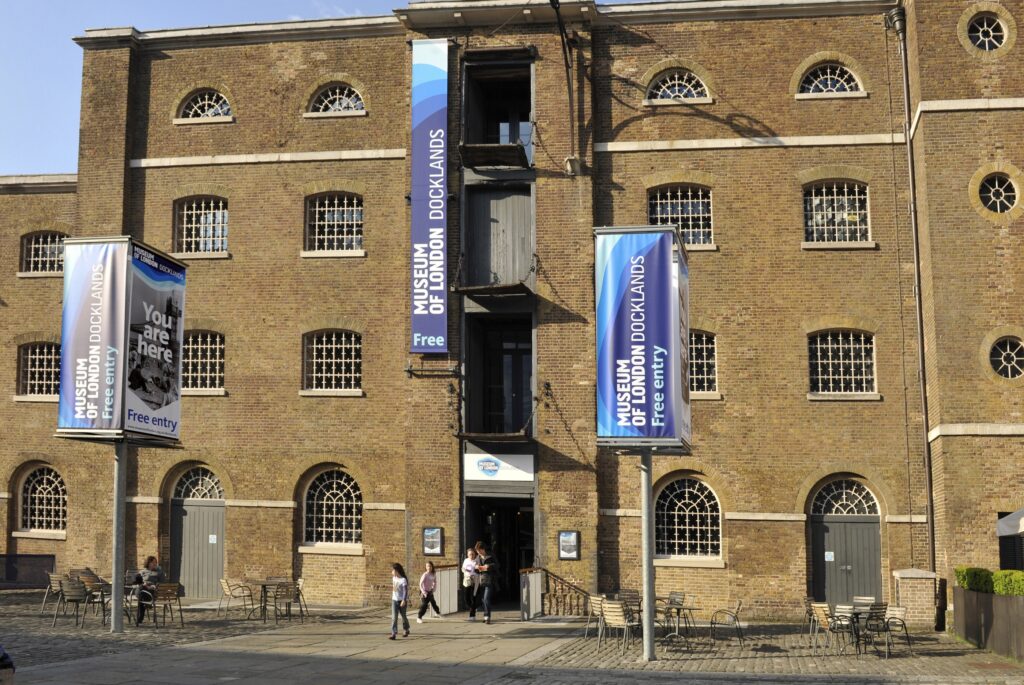
The Museum of London Docklands occupies a former warehouse (Photo: courtesy of Museum of London Docklands)
Museum of Civilisations of Europe and the Mediterranean, FRANCE
The MUCEM might not be a maritime museum strictly speaking, but its focus on Mediterranean culture and civilisations fully warrants a place in our selection. It presides over the entrance to Marseille’s harbour, comprising the 17th-century Fort Saint-Jean as part of the project. The semi-permanent exhibitions recount the great Mediterranean port cities of the 16th and 17th centuries (‘Connectivites’, until Sep 2023), and investigate the region’s food culture starting from the concept of ‘Mediterranean diet’ (‘The grand Meze’, until May 2024). The temporary exhibitions range from art and crafts to history, in keeping with the marked interdisciplinary approach of the museum.
1 Esp. J4, 13002 Marseille, France
Estonian Maritime Museum, ESTONIA
The Estonian Maritime Museum is split between a 500-year-old tower and a former hangar of 8000 sqm. The latter launched in 2012, boosting the museum’s popularity and making it the largest in the country. It is home to a highly-interactive display of seaplanes, sail ships and submarines, such as the WW2 Lembit submarine and the Suur Tõll icebreaker moored at the quay. The other half of the museum is housed at the 16th-century ‘Fat Margaret’ tower. Its highlights include the 20-metre-long wreck of a rare medieval cargo ship discovered in 2015.
Seaplane Harbour – Vesilennuki 6, 10145 Tallinn, Estonia
Fat Margaret – Pikk 70, 10133 Tallinn, Estonia
Vasa Museum, SWEDEN
The Vasa Museum celebrates the world’s best-preserved ship from the 17th century. A record-breaking war vessel measuring over 60 metres in length, the Vasa met its fate in the August of 1628, sinking on its maiden voyage upon encountering strong gusts just off Stockholm harbour. It was fished out 333 years later, and fully restored to its initial splendour. Remarkably, 98 per cent of the display consists of original parts. The spectacular wood carvings covering the ship mirror its ambition, while the reason for the engineering failure is still a matter of debate. Different displays provide context to this impressive maritime artefact, one of the most popular attractions of the Swedish capital.
Galärvarvsvägen 14, 115 21 Stockholm, Sweden
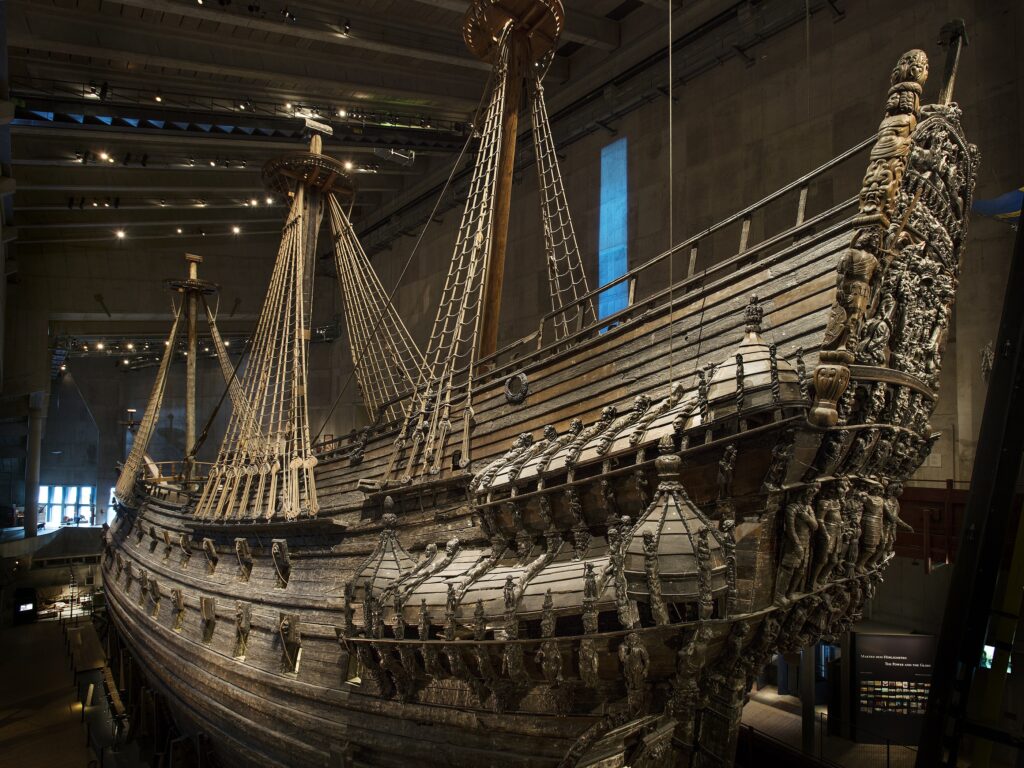
Elaborate woodcarving is among the Vasa’s impressive features (Photo: Anneli Karlsson, courtesy of Vasa Museum)
Betina Museum of Wooden Shipbuilding, CROATIA
Wooden shipbuilding is a way to meet the local community. Betina, a small harbour on the Croatian island of Murter, holds this traditional craft particularly dear, and the dedicated museum offers a peek into the life of the village past and present. All items on display were donated by locals, who are also involved in the programme of events and folklore demonstrations. A 3D game is available for children to get hands-on with the craft, while first-hand accounts from shipbuilders and other townspeople are screened. Among other boat models, visitors become particularly familiar with the local trademark gajeta (officially recognised as intangible cultural heritage in Croatia). The harbour serves as an outdoor section of the museum.
Vladimira Nazora 7, 22244, Betina, Croatia
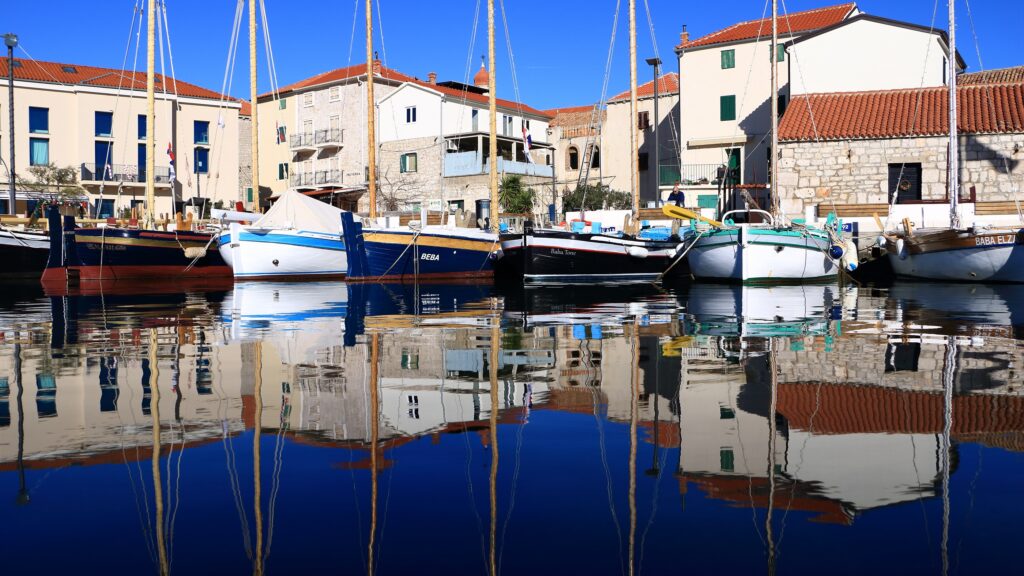
Boats moored at Betina harbour (Photo: courtesy of Muzeja Betinske Drvene Brodogradnje)
Internationales Maritimes Museum Hamburg, GERMANY
The IMM is housed in the oldest-standing warehouse in Hamburg, forming part of the recently-renovated Speicherstadt (‘warehouses district’). Both the building and the adjoining boomerang-shaped bridge are prime examples of the Neo-Gothic and Modernist architecture defining this area. The museum opened in 2008 to showcase the extensive private collection of journalist and collector Peter Tamm. Spread across ten floors, the exhibition includes model ships, uniforms, maritime art, construction plans, memorabilia and a professional ship simulator. Overall, a fitting addition to any visit of Hamburg’s old port.
Koreastraße 1, 20457 Hamburg, Germany
Maritime Museum of Finland, FINLAND
An architecturally-intriguing seaside complex houses this multipurpose maritime centre located in the town of Kokta. The ‘Faithful Svenskund’ permanent exhibit dives deep into the most significant battle ever fought in the Baltic Sea, which took place in nearby waters as part of the Russo-Swedish War (1790). Visitors come face-to-face with a collection of wrecks as a fascinating historical account unfolds, while virtual reality explores the consequences of that battle still lying on the seabed. ‘North Star, Southern Cross’ is an extensive display involving all things seafaring, both from Finland and across the globe. The impressive Tarmo icebreaker and a bright red lightship can also be visited (check availability according to the time of the year).
Tornatorintie 99, 48100 Kotka, Finland

The Tarmo icebreaker moored outside the museum (Photo: courtesy of Maritime Museum of Finland)
Sergej Masera Maritime Museum, SLOVENIA
A charming Adriatic town of Venetian and Hapsburg heritage, Piran is home to a scattered maritime centre presenting a range of exhibitions. The main collections are displayed at Palazzo Gabrielli, a local architectural highlight overlooking the mandracchio (small harbour). Alongside classic maritime art and artefacts, the displays provide insights into the town’s history, fishing culture and shipbuilding tradition. The off-site attractions include the Museum of Salt Making and the Monfort Warehouse, a rare example of a preserved salt silo dating back to the 19th century.
Cankarjevo nabrežje 3, 6330 Piran, Slovenia
Hurtigruten Museum, NORWAY
Paying homage to a historic ferry service in Norway, the Hurtigruten Museum got a brand new look in the summer of 2021. It features a full-sized ship (the MS Finnmarken 1959) enshrined within a contemporary steel-and-glass structure, creating an original mix of history, architecture and vistas over the sea. Visitors travel through time as they explore the different sections of the ship, learning all about the iconic ‘Coastal Express’ and the history of the Norwegian coast. The bridge, the engine room, the galley and the cabins are some of the spaces included on the exhibition route. The venue is part of an extensive network of museums in northern Norway, many of which have a maritime theme (Museum Nord).
Richard Withs gate 1, 8450 Stokmarknes, Norway
Istanbul Naval Museum, TURKEY
The maritime museum of Istanbul is Turkey’s chief showcase of Ottoman naval history. It is fittingly located next to the tomb of 16th-century admiral Barbaros Heyrettin Paşa, looking out over the Bosphorus Strait. While the museum dates back to 1897, its new exhibition hall opened as recently as 2013. This notable architecture is home to a three-story display of imperial caïques, wood carvings, ship models, naval ornaments and figureheads. The highlights include the only existing original galley in the world (Tariki Kadirga), and pieces of the Byzantine chain that used to block the entrance to the Golden Horn. One of the exhibits focuses on famed cartographer Piri Reis (circa 1465 – 1553).
Sinanpaşa, Beşiktaş Cd. No:6 D:1, 34353 Beşiktaş/İstanbul, Turkey
Euskal Itsas Museum, SPAIN
A small museum by the port, the Museo Maritimo Vasco is housed in an 18th-century tower-house that formerly hosted the merchants’ guild of San Sebastian. It offers insight into Basque maritime heritage through an open and participative approach. The current exhibit is a two-story account of Basque ports as vectors of economic, social and technological innovation, with a focus on the role they have played over the past 200 years (‘Moilak. Traditionally Innovative’, until 26 January 2024). A varied programme of activities for both children and adults runs alongside the exhibitions.
P.º del Muelle, 24, 20003 Donostia-San Sebastian, Gipuzkoa, Spain
Merseyside Maritime Museum, UNITED KINGDOM
Liverpool’s historic waterfront is home to an all-round collection about the city’s seafaring past. A whole section is dedicated to the Titanic, which was registered in Liverpool although never actually sailed there. Another great sinking is featured, that of the Lusitania liner torpedoed by a German submarine during WW1. Behind the scenes of Border and Customs, the waterfront, shipping posters and life on board are other themes explored across the museum’s four floors. The museum is part of the free-to-visit National Museums Liverpool, which also include the neighbouring International Slavery Museum. The visit can be paired with the Old Port guided tour (booking required).
Royal Albert Dock, Liverpool L3 4AQ, United Kingdom
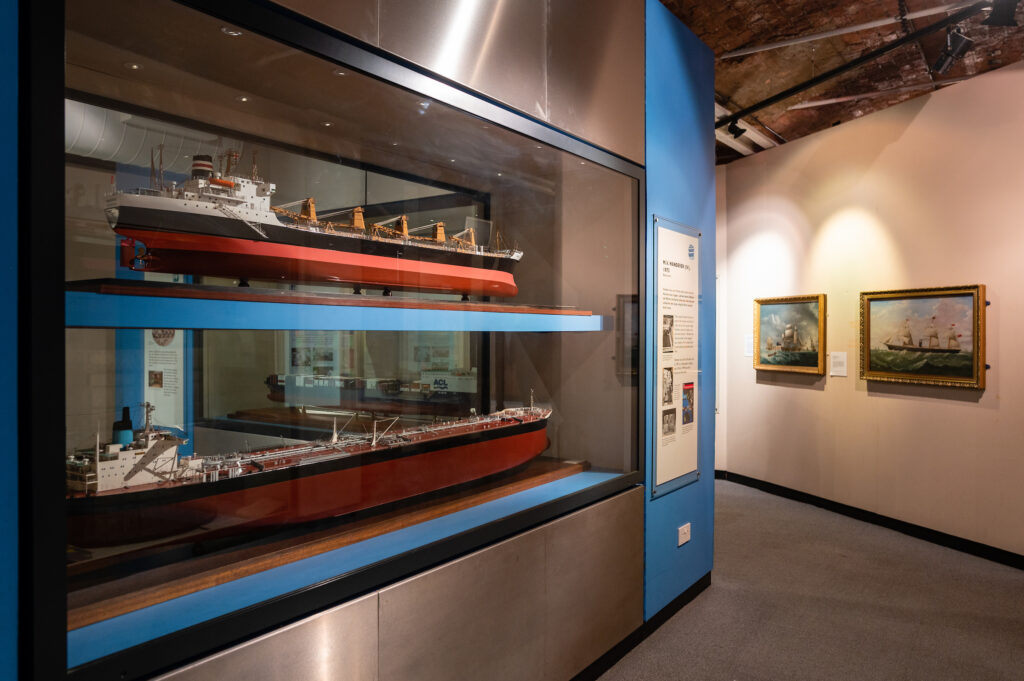
A room of the Merseyside Maritime-Museum (Photo: Pete Carr, courtesy of Merseyside Maritime Museum)
Cesenatico Maritime Museum, ITALY
A small fleet of historic sailboats populates the Leonardo-designed canal port of Cesenatico (Emilia-Romagna). It is the only floating museum in Italy, showcasing the maritime traditions of the upper Adriatic Sea as part of the Museo della Marineria. More boats are displayed in the indoor section, which also explores shipbuilding, fishing and the life of seafarers. The surrounding community of fishermen enhances the visit, serving as a living extension of the exhibition spaces. Two nearby museums are included in the visit, while the floating exhibit is free. The historic boats flaunt their colourful sails every day from mid-June until the end of August.
Via Carlo Armellini, 18, 47042 Cesenatico (FC), Italy

The historic boats of Cesenatico (Photo: courtesy of Museo della Marineria di Cesenatico)
Museum Kaap Skil, NETHERLANDS
Another locally-focused museum, Kaap Skil is located on the Wadden island of Texel, North Holland. The architecture award-winning wooden building houses a range of exhibits about the key role the island played at the golden age of Dutch seafaring. An interactive scale model is one of the highlights, portraying the impressive roadstead that could harbour up to 150 ships off the coast of the island. A rich collection of objects retrieved from ancient shipwrecks is displayed, such as the extraordinary textiles of the Palmood wreck. The open-air section includes a working grain mill as well as exhibitions about fishing, shipping and beachcombing. From May to October, traditional craftspeople such as net-menders, ropemakers and blacksmiths showcase life on the island as it used to be.
Heemskerckstraat 9, 1792 AA Oudeschild, Netherlands
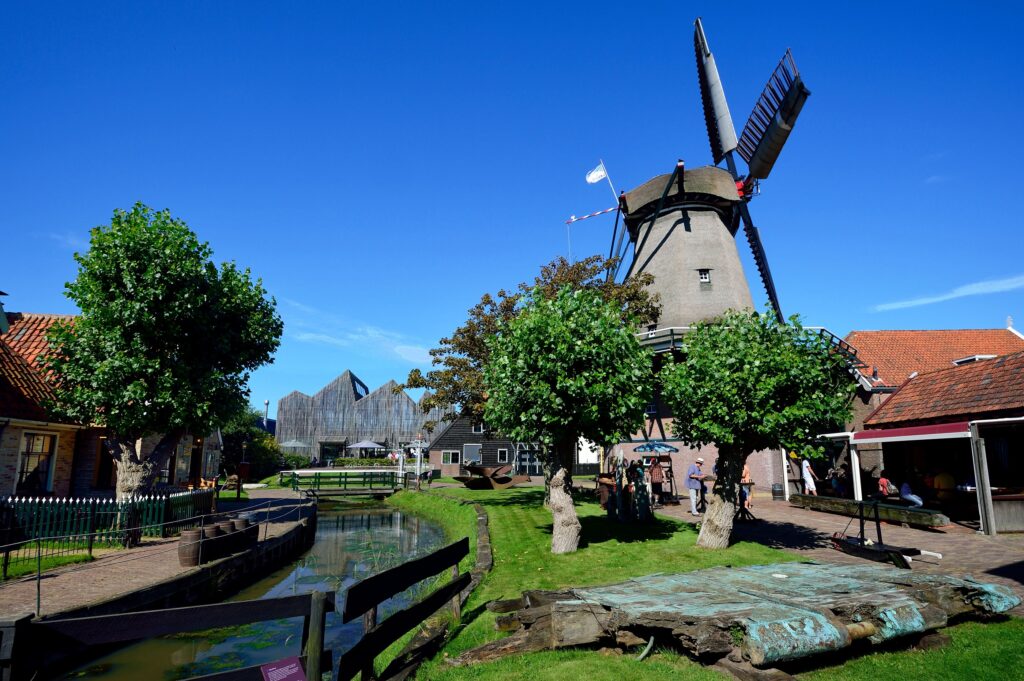
The open-air section of Museum Kaap Skil, with the main building in the background (Photo: Mike Bing, courtesy of Museum Kaap Skil)
Cité de la Mer, FRANCE
The City of the Sea is housed in a grand art-deco building which previously served as a transatlantic cruise terminal. It is one of Normandy’s top attractions, a family museum revolving around sea life and adventure. The hall displays a large collection of submarines and diving machines, highlighting some of the most daring explorations of the abysses in history. A whole section is dedicated to the story of the Titanic, while the three-floor ‘The Ocean of the Future’ features multimedia displays and spectacular aquariums. Visitors can board the Redautable submarine, or embark on a virtual expedition at the helm of the Furtif.
All. du Président Menut, 50100 Cherbourg-en-Cotentin, France
